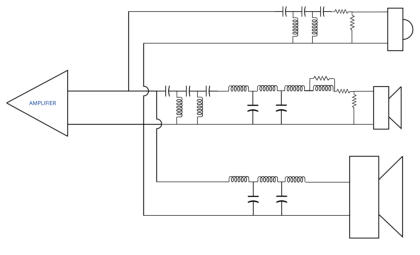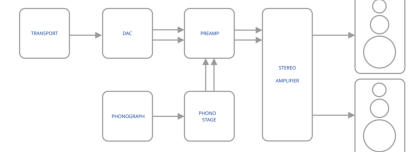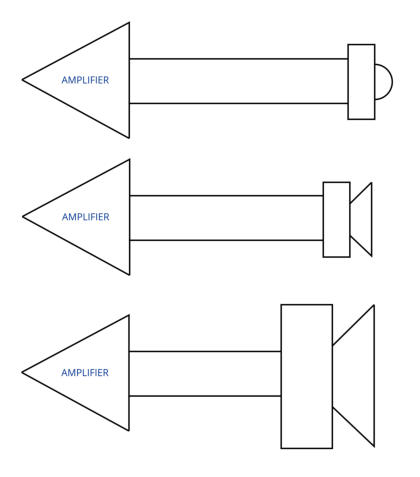
#1 ELIMINATION OF THE PASSIVE FILTER
Upgrading from archaic passive filters is only the first step in applying the new technologies. It
kind-of goes without saying that: “passives are bad” and that getting rid of them is great. But, at
the risk of showing you something too simple, let’s take a quick look at why.
For generations, we’ve put a stereo together more or less like this:
That format necessitated that the speaker contain a set of filter circuits, called the crossover, who’s
job was to divide the signal into bass, midrange and trebles, then send that filtered signal to the
assigned driver. The reason behind this standardization was the limit imposed by the two-channel
stereo amp; it delivered two full range signals, one to each speaker. At the time, that made sense
because amps were large and expensive.
That resulted in a collection of Inductor/Capacitor/Resistor circuits every speaker commonly called
the crossover. On the design side, we all knew how critical it was. But, out of sight, out of mind; the
crossover was rarely even discussed at the retail level.
What’s the problem? Capacitors and inductors do their jobs by absorbing energy and releasing it
later. Simply: they are resonant. As a bell rings: you strike it, imparting energy, that comes back out
a little later. That is a distortion. In addition, each of those parts comes with it its own peculiar set
of other distortions that comprise its character. In addition to that, different amplifiers handle
these kinds of reactive loads differently; which explains the “black art” of speaker/amp matching.
Back in the day, I used to design with a carousel of different amps, just to be sure that my designs
worked nicely with all amp types. The point is: never was a speaker optimized for one amplifier;
instead there was some “splitting of babies”.
There’s another layer to the problem with passive filters. Setting aside the problems that arise from
the resonance of capacitors and inductors, they also present impedance. They impede the flow of
current.
To simplify the explanation, consider this comparison: amp drives woofer directly vs amp drives
woofer thru a simple resistor.
Of course, the resistor lowers the output of the woofer by converting some of the power into heat,
but the real problem is that adding resistance raises the Q of the woofer/enclosure system. In non-
engineering terms: increases the woofer’s “ringy-ness”, particularly at the system’s fundamental
resonance frequency.
That resistance decouples the driver from the amp, throwing away valuable electrical damping.
Ideally, you want the amp to dictate the driver’s position from moment to moment; the
instantaneous voltage determining the voice coil’s position from moment to moment. But the
added resistance loosens the amp’s grip, yielding its control to the moving system’s inertia,
suspension elasticity, and the resonant characteristics of the system as a whole. The mechanical
analog of this situation is: the difference between moving a load with a stiff stick, or with a springy
soft thing. So yes, as you increase the amount of impedance, you’ll observe a fattening at the
bottom end, and an overall softness of attack and resolve. Even the simplest, highest quality
passive filter has some of this effect.
Back in the 1990s, I built the Meadowlark brand based upon extremely well executed passive filters.
I spent endless hours fussing over them, and established a reputation for a “rightness” of
presentation. And we did successfully show that the quality of those components matter greatly,
with our best selling HOTROD series. Same circuits, better parts.
I did my best to lessen the harm caused by passive filters; hated them the whole time. But now we
move on: “better design and better parts” a far cry from directly coupled to the amplifier. That
brings us to the present. A new generation of functionally ideal, tiny and very powerful amplifier
modules can be built, in multiples, into each speaker, so we can finally build them like this:
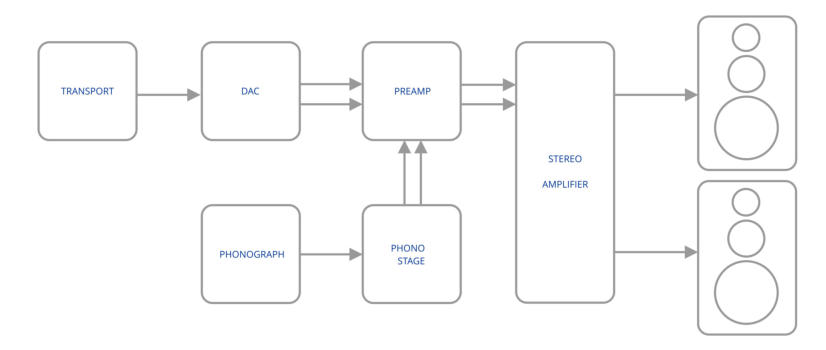
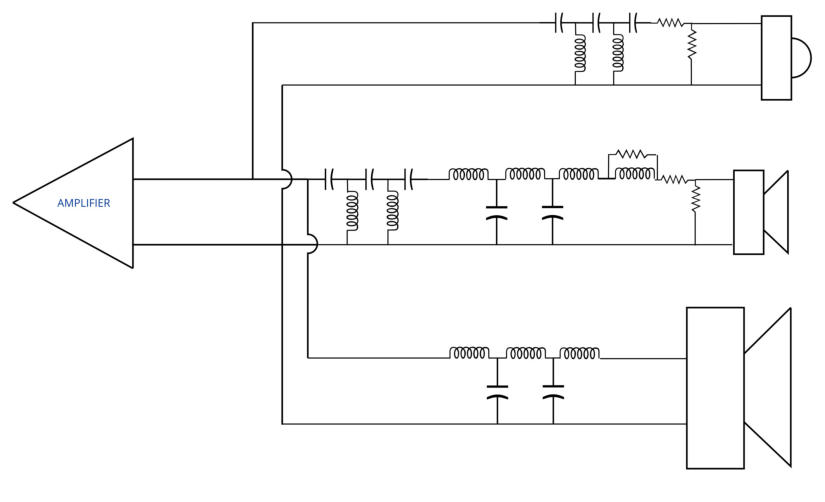
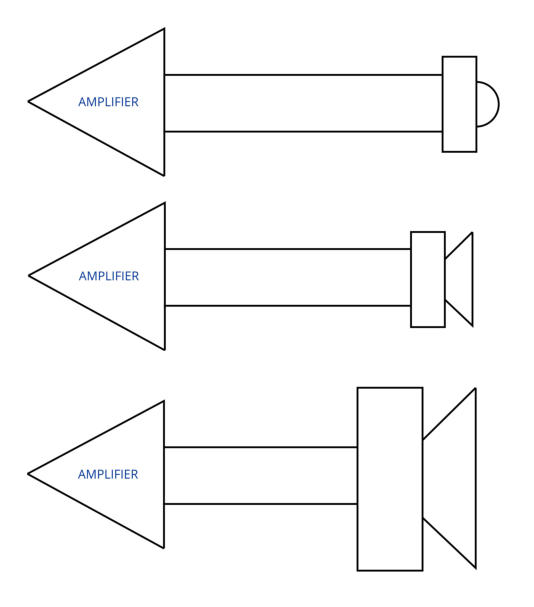







#1 ELIMINATION OF THE PASSIVE FILTER
Upgrading from archaic passive filters is only
the first step in applying the new technologies.
It kind-of goes without saying that: “passives are
bad” and that getting rid of them is great. But,
at the risk of showing you something too
simple, let’s take a quick look at why.
For generations, we’ve put a stereo together
more or less like this:
That format necessitated that the speaker
contain a set of filter circuits, called the
crossover, who’s job was to divide the signal
into bass, midrange and trebles, then send that
filtered signal to the assigned driver. The reason
behind this standardization was the limit
imposed by the two-channel stereo amp; it
delivered two full range signals, one to each
speaker. At the time, that made sense because
amps were large and expensive.
That resulted in a collection of
Inductor/Capacitor/Resistor circuits every
speaker commonly called the crossover. On the
design side, we all knew how critical it was. But,
out of sight, out of mind; the crossover was
rarely even discussed at the retail level.
What’s the problem? Capacitors and inductors
do their jobs by absorbing energy and releasing
it later. Simply: they are resonant. As a bell
rings: you strike it, imparting energy, that
comes back out a little later. That is a distortion.
In addition, each of those parts comes with it its
own peculiar set of other distortions that
comprise its character. In addition to that,
different amplifiers handle these kinds of
reactive loads differently; which explains the
“black art” of speaker/amp matching. Back in
the day, I used to design with a carousel of
different amps, just to be sure that my designs
worked nicely with all amp types. The point is:
never was a speaker optimized for one
amplifier; instead there was some “splitting of
babies”.
There’s another layer to the problem with
passive filters. Setting aside the problems that
arise from the resonance of capacitors and
inductors, they also present impedance. They
impede the flow of current.
To simplify the explanation, consider this
comparison: amp drives woofer directly vs amp
drives woofer thru a simple resistor.
Of course, the resistor lowers the output of the
woofer by converting some of the power into
heat, but the real problem is that adding
resistance raises the Q of the woofer/enclosure
system. In non-engineering terms: increases
the woofer’s “ringy-ness”, particularly at the
system’s fundamental resonance frequency.
That resistance decouples the driver from the
amp, throwing away valuable electrical
damping. Ideally, you want the amp to dictate
the driver’s position from moment to moment;
the instantaneous voltage determining the
voice coil’s position from moment to moment.
But the added resistance loosens the amp’s grip,
yielding its control to the moving system’s
inertia, suspension elasticity, and the resonant
characteristics of the system as a whole. The
mechanical analog of this situation is: the
difference between moving a load with a stiff
stick, or with a springy soft thing. So yes, as you
increase the amount of impedance, you’ll
observe a fattening at the bottom end, and an
overall softness of attack and resolve. Even the
simplest, highest quality passive filter has some
of this effect.
Back in the 1990s, I built the Meadowlark brand
based upon extremely well executed passive
filters. I spent endless hours fussing over them,
and established a reputation for a “rightness” of
presentation. And we did successfully show that
the quality of those components matter greatly,
with our best selling HOTROD series. Same
circuits, better parts.
I did my best to lessen the harm caused by
passive filters; hated them the whole time. But
now we move on: “better design and better
parts” a far cry from directly coupled to the
amplifier. That brings us to the present. A new
generation of functionally ideal, tiny and very
powerful amplifier modules can be built, in
multiples, into each speaker, so we can finally
build them like this:
